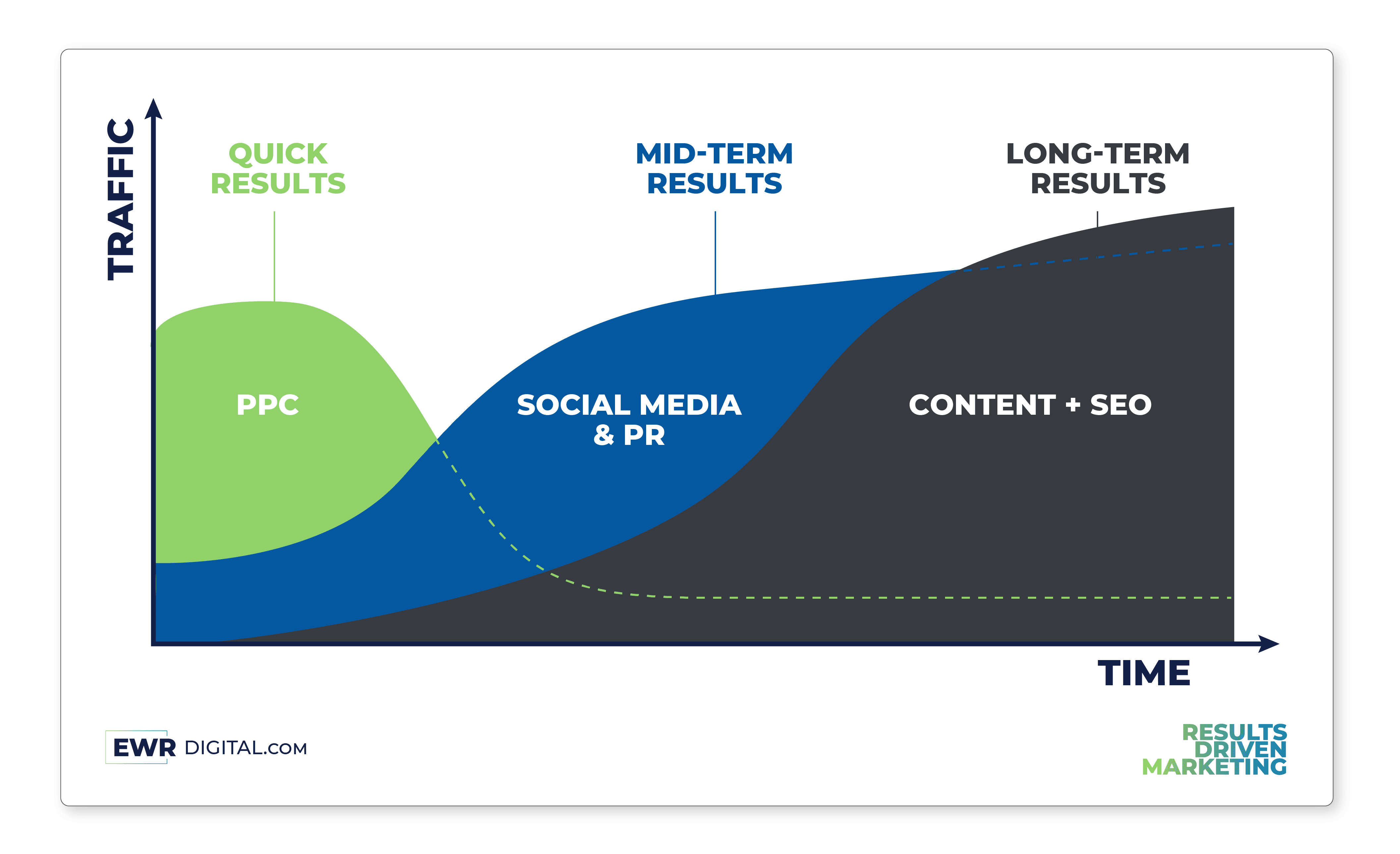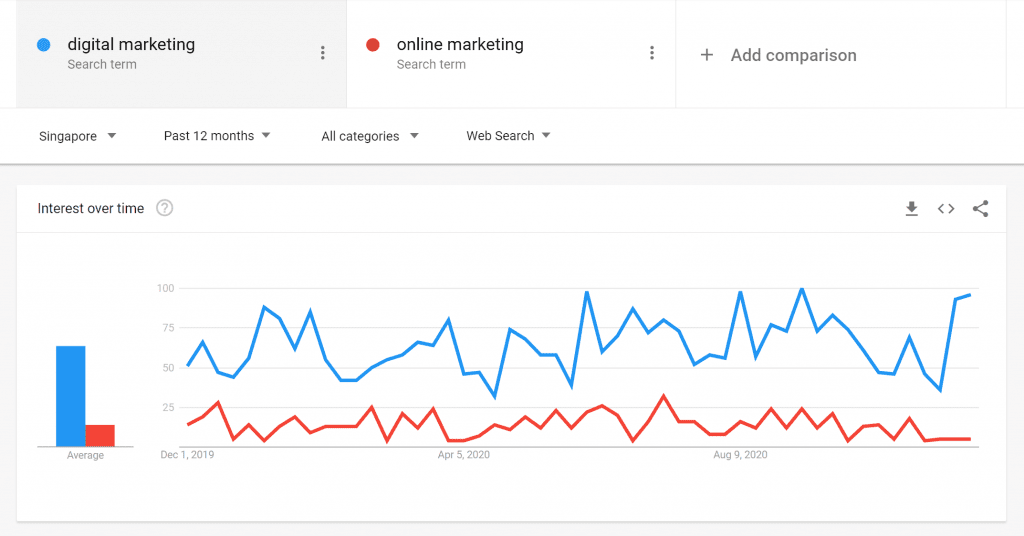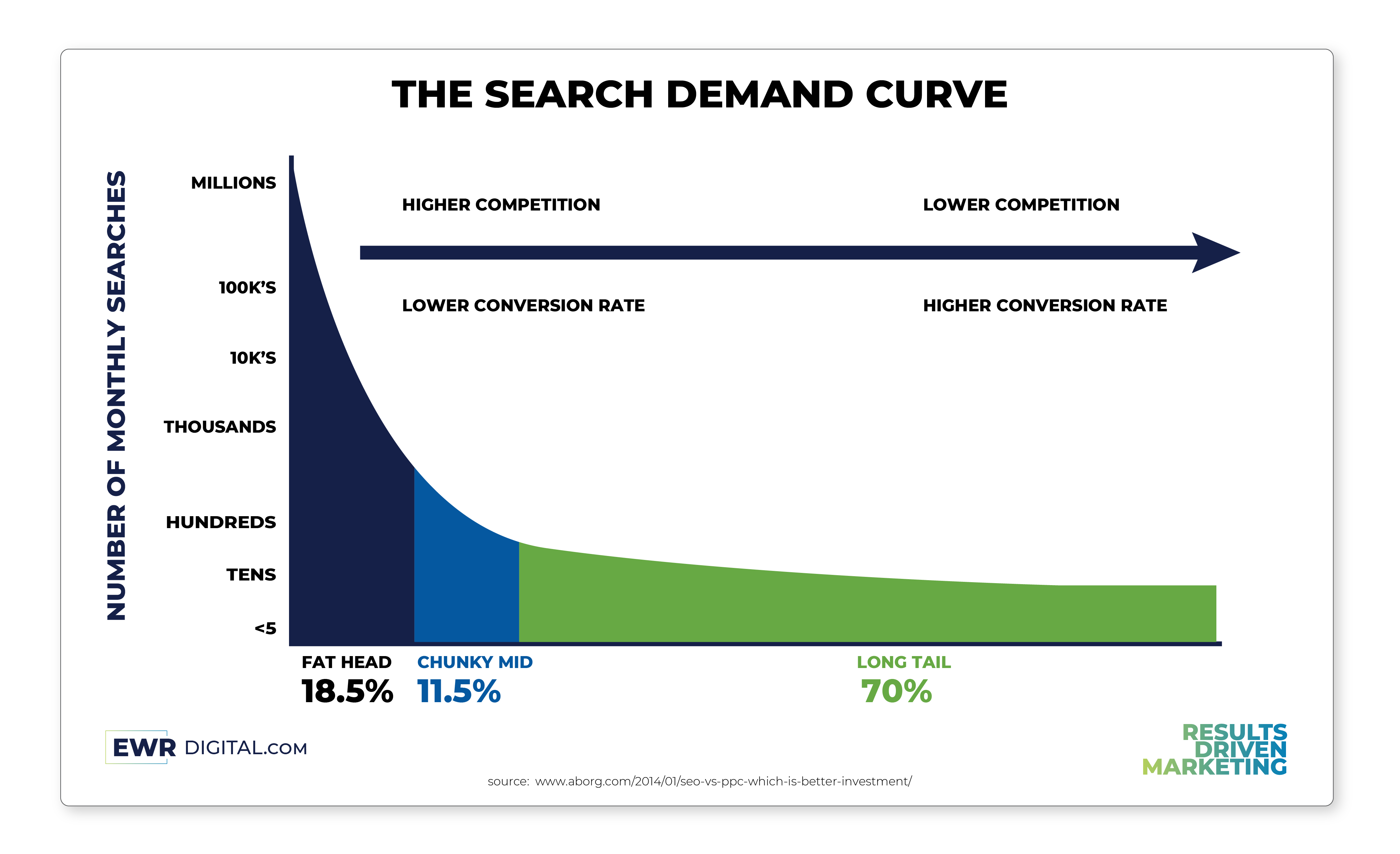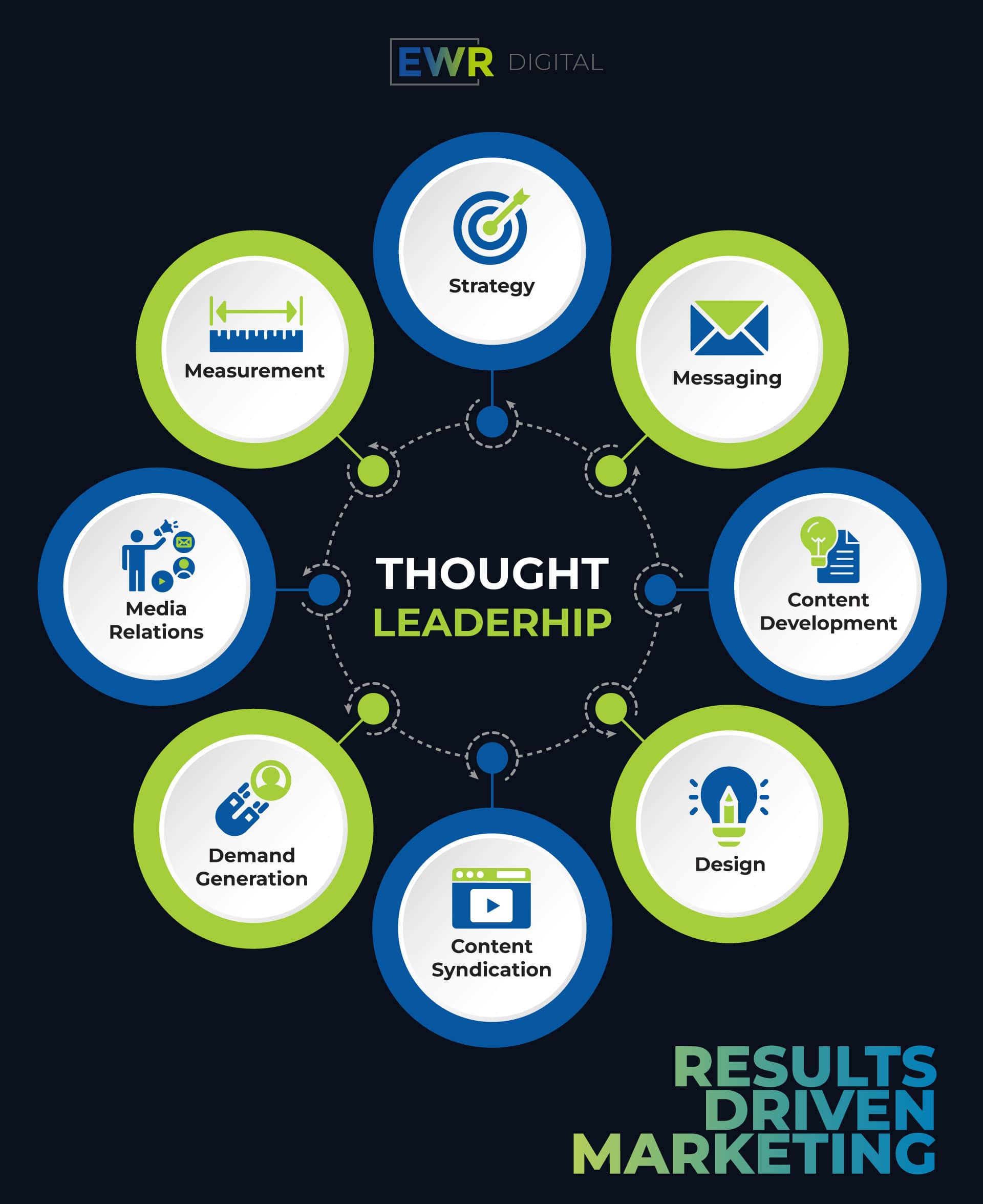If your organization only considers its sales goals every month or quarter, is that the only metric you should be looking at? Is that a recipe for success, or may that be leaving success up to chance? You probably already know that in order to see real results, you must take action daily.
“Companies that actively monitor trends are 60% more likely to anticipate and respond effectively to market shifts, compared to those that don’t.” – Gartner
Digital marketing thought leaders tell you “attention spans are so short these days” — but what about your own attention span? Are you focusing, on a daily basis, on what really matters to you, what you want, and what actions you will take to move the needle on a daily basis? Are you obsessed? EWR Digital’s obsession is with your SEO, your website’s keyword ranking, and your traffic. Search engine optimization is not a one-shot deal — it requires recurring focus and effort to keep your keyword rankings where they are (and ideally) grow them, and pursue new opportunities — so that your website traffic steadily increases and your business grows.
To survive and thrive, your business must understand trends and integrate them into your marketing and sales strategies! If your company doesn’t have a good trend monitoring strategy, its information will always be out of date, so how can you build a trend monitoring strategy and keep your business on the cutting edge?
1. Identify Thought Leaders
Your trend monitoring strategy is driven by a simple idea: work smarter, not harder. Instead of reinventing the wheel, monitor trends by identifying thought leaders within your industry.
A thought leader is someone who is recognized as an authority in a particular field and whose ideas and opinions are highly influential. They are often sought out for their expertise and insights on various topics within their industry or area of specialization. You should consider becoming a thought leader yourself.

IMPACT OF THOUGHT LEADERSHIP ON INDUSTRY TRENDS
Thought leaders share their knowledge through writing, speaking engagements, social media, and other platforms, and they contribute to shaping the direction of their field by introducing new perspectives, challenging existing norms, and driving innovation.
Thought leaders stay on top of emerging trends and share their insights with the world. By actively following such leaders, you can learn about trends when it is still very fresh.
Even if you already consider your business to be a thought leader, who are your peers? What thought leaders could you monitor in order to stay on top of the trends, topics, keywords, problems, and solutions that your audience cares about?
You probably already do this in an informal way — you most likely read specific blogs, are subscribed to email newsletters, and watch social media accounts in your feed relevant to your industry. Why not do this deliberately, consistently, and purposefully?
In time, your own business may pivot to its thought leadership role. Until that time, however, you can rely on today’s thought leaders to help you develop the strategies of tomorrow.
IDENTIFYING INFLUENCERS IN YOUR INDUSTRY
Consider this: search for a keyword representing your industry on Instagram or LinkedIn, and notice accounts with a following of 100,000 or more. What “job titles” or “sub-niches” do you notice on these accounts?
For example, EWR Digital works in the oil and space. When I search the term “oil and gas marketing” and change the search settings to show People, I see:
- oil and gas investor
- oil and gas trader
- oil and gas operations
- oil and gas logistics
You can then re-perform these longer tail searches and follow a handful of the most popular accounts in these areas.
You should consider becoming a thought leader yourself.

2. Stay On Top of Social Media
You may not be a very big fan of social media when it comes to your personal life. However, in your business, social media is one of the most important tools you can use.
The algorithm of any social media platform looks at what you already follow, what you react to (liking, commenting, sharing, even viewing for more than a few seconds), and what your friends respond to. They then serve more of that content to you, in an attempt to capture your attention and get more engagement from you.
Unfortunately, the human mind responds to danger, and this is why headlines are sensationalist clickbait — because they need to be, in order to stand out in a crowded marketplace. The saying in journalism is: “If it bleeds, it leads.” You respond to the overblown, urgent, anxiety-inducing, clickbait headlines — because you are a normal person — and the social media algorithms serve up more shocking content to you. Garbage in, garbage out!

OPTIMIZING SOCIAL MEDIA CONSUMPTION
You can use your logical mind to take control back and change your feed. You should unfollow any general mass hysteria and focus on the leaders in your industry. You probably already follow a few, but it’s time to deliberately fill your feed with a “social media swipe file” that gives you a fresh supply of ideas.
- Which thought leaders would you consider your peers? Perhaps you have not connected in a while or viewed their content.
- Who absolutely dominates in your industry? What companies are several “levels” ahead of you in scale?
- Which company pages and personal profiles could you follow that are not at all related to your business, but do a wonderful job posting engaging content? What captures your attention about them? How often do they post, what do they post, what seems to be their content structure or strategy?
In addition to following these thought leaders, an amazingly underused, but obvious, feature of post social media platforms is the “global keyword search” functionality. If you use Reddit as a research tool, you’re used to performing a keyword search on the entire platform. But very few people think to perform a keyword search of all recent posts on a social network.

ADVANCED SOCIAL MEDIA SEARCH TECHNIQUES
When you use Facebook, LinkedIn, Instagram, Twitter (X), the default browsing mode is your news feed — what they think you want to see — relevant and somewhat recent posts by your friends and the pages you follow. However, you should make it a habit of performing a few long-tail keyword searches of recent posts, especially from accounts you don’t follow.
EWR Digital has some big clients in the oil and gas space. We even support the operaations of a podcast network called the Oil & Gas Global Network. In order to stay on top of the latest trends, we might search phrases such as:
- oil and gas podcasts
- oil and gas books
- oil and gas speakers
- oil and gas sustainability
- oil and gas trends
To be clear, when you perform a keyword search on social media, they do not show you the global posts by default. You must search, then choose to show Posts on the platform. Then, either sort by most recent posts or the top posts in the last 24 hour period. The key here is recency, not popularity. Platforms such as LinkedIn also allow for “saved searches” so you can easily re-visit on a regular basis.
You will quickly get an idea about what topics people are talking about, who is posting consistently, who is re-sharing (your content and your competitors). What you’ll find amazing is that because you are looking at recent posts — say, something posted 3 hours ago — it won’t have a ton of engagement and you will stand out if you like, share, or leave a thoughtful comment on someone’s recent social media post. This is part of you getting noticed, staying relevant, and being a thought leader of your own.

ENGAGING WITH INDUSTRY-SPECIFIC SOCIAL MEDIA CONTENT
You are training the algorithm of each social media platform to show you relevant content in your industry, you are building goodwill (relationships) with people in your space, and you are getting ideas for your own content.
When you post your own content, interact with your audience — respond to comments, ask questions, and share user-generated content. Leverage user-generated content by reposting photos from happy customers who tag your products in their own posts.
The goal is to use social media marketing is to connect with your target audience, build relationships, and ultimately drive sales or bookings for your business.
You’d create visually appealing posts featuring your products, maybe with lifestyle images showing how they can be used in a home setting. You might also run ads targeted at people who are interested in home decor or similar products.
Engagement is key, so you’d interact with your audience by responding to comments, asking questions, and sharing user-generated content. You could also leverage user-generated content by reposting photos from happy customers who tag your products in their own posts.
And don’t forget about influencers! Partnering with influencers who have a strong following in your niche can help you reach new customers and build credibility for your brand.

Now, maybe your in home services space:
Let’s say you run a home cleaning service. Social media marketing for home services involves using platforms like Facebook, Instagram, and even LinkedIn to reach potential clients and showcase your expertise.
You’d create content that highlights the benefits of your service, maybe with before-and-after photos of clean homes or videos showing your team in action. You could also share tips for maintaining a clean home or highlight the importance of professional cleaning services.
Engagement is still important here, so you’d respond to comments and messages promptly, address any concerns or questions people might have, and maybe even offer special promotions or discounts to your followers.
And just like with ecommerce, influencers can be valuable partners. Look for influencers who have a strong local following and whose values align with your brand, and consider collaborating with them to reach new clients in your area.
In both cases, the goal is to use social media to connect with your target audience, build relationships, and ultimately drive sales or bookings for your business!
3. Join Relevant Online Communities
“Online communities are the new town squares, where connections form, ideas are shared, and support is found, transcending geographical boundaries.”
The next step is to find online communities with interests that are relevant to those of your business. When you research people and keywords in the above steps, you will accidentally find groups these thought leaders share from and post in.
Join groups relevant to your industry and “lurk” without saying anything. Pay attention to what people are posting.
Online groups are a form of crowdsourcing. Monitor what industry professionals are concerned about on a regular basis and you will spot widespread issues within that industry. On the flip side, when you see exciting news, you can monitor emerging trends and innovations that may positively impact your own business.
THE IMPORTANCE OF DIVERSE INDUSTRY INTERACTIONS
It’s important that you pay attention to this fresh supply of ideas, problems, and content hooks. Otherwise, it’s easy to get trapped in your own thinking or the limited topics discussed within your own bubble. Stay curious about what concerns these group members.
There are several online communities beyond Twitter, LinkedIn, and Reddit where you can engage with your target audience and network with other professionals in your industry. Here are some relevant ones:
- Facebook Groups: For example, there Facebook groups dedicated to ecommerce selling, home services, and related topics. Look for groups where your target audience hangs out, such as “Ecommerce Entrepreneurs” or “Home Improvement Professionals.” Engage with members by offering advice, sharing your expertise, and networking with potential clients or collaborators.
- Instagram: While primarily a visual platform, Instagram also fosters community through hashtags and engagement with followers. Use relevant hashtags in your posts to reach a wider audience interested in ecommerce or home services. Participate in Instagram challenges, collaborate with other businesses, and engage with your followers through comments and direct messages.
- Pinterest: Pinterest is a popular platform for discovering and sharing ideas related to home decor, DIY projects, and ecommerce products. Create visually appealing pins featuring your products or home service offerings, and join group boards where you can share your content with a larger audience.
- Quora: Quora is a question-and-answer platform where users can ask and answer questions on a wide range of topics. Search for questions related to ecommerce selling, home services, or your specific niche, and provide helpful answers to establish yourself as a knowledgeable authority in your field.
CASE STUDY: LEVERAGING INDUSTRY NETWORKS
EWR Digital helps contractors strategize their digital strategy when it comes to marketing their home services. We could join “roofing” groups to see what roofers, and other marketing companies targeting roofers, are talking about. For example, when I browse through a large LinkedIn group called The Roofing Forum, I see the following:
- an upcoming local live event for roofers to learn a better process for estimation and cost management
- a comprehensive PDF whitepaper about concrete fibers (a specific sub-topic relevant to this industry)
- a slightly spammy post advertising lead generation services for marketing companies (the average person would ignore this, but you could make a mental note about this as a general trend)
- a commercial roofing trends report (great to understand recent industry statistics, both in terms of numbers and what other factors people are concerned about)
- a before-and-after photo re-shared from a contracting company showing how they waterproofed the retaining walls of a building structure
Join these groups with a curious mindset. Notice what sorts of posts interest you, who is posting, and consider how they inspire you to post similar types of content.

4. Use Google Trends
Social media is a great way to monitor emerging trends, but you may notice there is a bit of “luck” involved — many of the ideas you see come from the posts you happen to notice. Google Trends allows you to effortlessly monitor what people say across various websites and social media platforms, on a larger scale. This is the best of both worlds, providing you with convenient trend monitoring data without excluding any important sites.
Google Trends allows you to set up alerts for keywords. When new content appears on the internet with those search terms, you get notified. The obvious usage for this is to enter your company name, so you get notified about new internet content mentioning you. But have you also considered these possibilities with Google Trends or Google Alerts?
- set Google alerts for your company’s phone number, email address, and physical address: wouldn’t you want to know if a new review site mentions you, or an online discussion is mentioning how to contact you?
- set alerts for your own names and competitor names
- events and conferences: are you attending a live event in your space later this year? You should be aware of developments regarding that event, and especially its guest speakers, so by the time you attend, you are fully informed
- local Google alerts (your profession plus your city name or neighboring cities), top keywords you rank for (so you can notice up and coming competitors), and titles of your most popular blog post (so you can see where they are re-shared)

EFFECTIVE KEYWORD STRATEGY FOR LAW FIRMS
One of EWR Digital’s lawyer marketing clients is David Hunter Law Firm which serves Fort Bend County, Texas. When you look at that web page, you can see we approach the keyword strategy from a few different angles:
- legal service keywords: Criminal Defense Attorney in Fort Bend County, DWI Attorney in Fort Bend County, Domestic Violence Attorney in Fort Bend County, Drug Possession Attorney in Fort Bend County
- geographic keywords: Top Criminal Defense Fort Bend Law Firm, Criminal Defense Attorney Katy TX, DWI Lawyer Sugar Land, Drug Possession Defense Rosenberg
- FAQ keywords: What are the steps in a criminal defense case in Texas, Legal rights after an arrest in Fort Bend County, What to do if you’re charged with drug possession in Fort Bend
Most of your competitors are not brainstorming, searching, and monitoring their keywords in this way, but it is essential if you want to expand your SEO reach and defend your position in the rankings.
The only downside of Google Trends is that you must overcome a learning curve to get the most out of it. Nonetheless, it’s worth your time to master this particular tool.

5. Customer Outreach
The “trend” in the above strategies has been to keep your focus on the people. If you don’t know what you’re doing with search engine optimization, organic traffic, and content authority, then it’s easy to fall into the mechanics of looking at search volumes or possible keywords. It always comes back to the people: Who are the thought leaders and what are they saying? Who are the prospects and what are they searching?
An extremely underused resource in your trend monitoring and keyword research is: your customers. Many business owners think in two extremes: who are my existing customers, and who are my future customers?
ANALYZING CUSTOMER DATA FOR TARGETED MARKETING
Consider the “attributes” of the customers you have already — you have built a database of people over time through a combination of deliberate messaging and accidental (unconscious) action. What attracted your existing customers to you? Where did you post, what ads did you run, what content did you market, what were the traffic sources?
You probably already keep up with loyal customers through mailing lists and social media. You can learn a lot about what’s trending and what your customers are interested in by asking them open-ended questions, and offering surveys.
Analytics are everywhere. You can look at your most popular email broadcasts (those that get the most clicks), your top viewed web pages (from Google Analytics 4), the Google keyword searches that lead the most people to your site. You can visit each of your social media platforms and look at those posts that received the most engagement in the past year or quarter.
CLIENT SUCCESS STORY: ALAN SMITH POOLS
One of our past favorite clients is Alan Smith Pools, based in Orange, California. His company provides many services including pool leak detection, pool construction, tiling — but “pool repair” is an interesting topic for Alan to drill down on. Many pool owners try to repair their own pools, leading to disaster. Alan’s content educates his future customers about the various skills (troweling, concrete, construction) involved in pool repair that DIY’ers may not estimate. We provide him web design, social media managment and pool search marketing.
Furthermore, Alan brings awareness about the cost-saving value of preventive maintenance including mastic, tiles, coping, plaster, steps, plumbing equipment, plumbing lines, and concrete.
Alan could extract a lot of information value by asking his customers what problems brought them to him. Perhaps they tried to perform some of the tasks themselves, or it became too time-consuming, or they simply wanted the job performed correctly.
The key to marketing is speaking to your prospect’s fears and frustrations — as if you are reading from a page in their diary. Speak to your customers and consider their response through multiple layers of interpretation:
- What seems to be the “recurring trend” as far as the general problem and solution? What are the repeat topics?
- Is there an exact way your customers phrase their concerns? Is there specific wording you can mirror back to future customers?
- Are there hidden underlying “sub-problems” (root causes) buried even deeper than the problems these people express to you? Are they perhaps focusing on the wrong problem?
- Is your customer educated “just enough to be dangerous” and are trying to make an A or B decision based on their existing knowledge?
Your business solves real problems for real people. Ask your customers about themselves so you can repurpose that data to attract and capture a larger, similar “lookalike” audience.

6. Monitor Hashtags
Earlier, we discussed the benefits of monitoring social media trends. While there are multiple ways to do this, you should pay special attention to the hashtags users develop.
On the most basic level, hashtags are useful for collecting many user posts under a single umbrella. This can help you do a deep dive into whatever is trending at the moment.
On a more advanced level, hashtags can serve as inspiration for your future digital marketing efforts. By crafting a catchy hashtag, you won’t have to settle for monitoring what is trending. Instead, you can watch your marketing go viral.
Pay special attention to the hashtags that develop. If you’re unaware, a #hashtag is a way to categorize or sort social media content. Hashtags are useful for collecting many user posts under a single umbrella. This can help you do a deep dive into whatever is trending at the moment.
On a more advanced level, hashtags can serve as inspiration for your future digital marketing efforts. When you perform the immersive research we are telling you about — looking at thought leaders, posts and groups — you’ll see the same hashtags used repeatedly. Many times, I will browse through the most recent posts on one single Instagram or TikTok account just to see if that person uses the same tags on repeat.
ACHIEVING CLIENT GOALS WITH TAILORED SEO STRATEGIES
We have a longtime client, First Capital Business Finance, who helps small, middle market businesses, and large corporations with financing options for bad credit — with services including Commercial Truck Financing, Construction Equipment Financing, Commercial Equipment Leasing, and Working Capital Business Loans. They said that EWR Digital was the only SEO company they hired that actually did what was promised for the last 10 years!
The industry leaders in their space post content with hashtags like #CommercialFinancing, #TruckFinancing, #StartupFinancing, #FinanceEducation. An ongoing approach could include regularly monitoring the posts with those hashtags on social media, responding to that content, and using those “content” leads to further find thought leaders to network with, and create our own content for our client.

7. Scope the Competition
Every trend monitoring strategy is reactive by nature. You must first see what others are doing and then develop your response. But what if you could cut the middlemen out of this process?
Most of our trend monitoring strategies involve casting a wide net and seeing what different groups and businesses are doing and saying. However, if you want to save a lot of time, you can focus on what your competition is currently doing.
You don’t have to adjust your monitoring strategies very much to keep a closer eye on your competition. Additionally, because you share the same industry and the same demographics, you can be sure that their different strategies and innovations will be effective for your business.
Every trend monitoring strategy is reactive by nature. Observe the actions others take and develop your response. But what if you could cut the middlemen out of this process?
Most of our trend monitoring strategies involve casting a wide net and seeing what different groups and businesses are doing and saying. However, if you want to save a lot of time, focus on what your competition is currently doing.
COMPETITIVE ANALYSIS IN PRACTICE
Keep a closer eye on your competition. Because you share the same industry and the same demographics, their strategies and innovations will be effective for your business. Checking out the competition can be a little emotional and painful — they rank higher for me than this keyword, they post more often than I do with better videos, their website loads faster, they’re listed in more business directories!
When you monitor your competition — regularly viewing their social media activity, webpages, and keyword ranking — you benefit in several ways. First, by viewing many competitors, you get a better feel for what’s working in your industry, or at least, what everyone else is trying. You get an intuitive feel when something is off — for example, someone has a design with colors drastically different than others in your industry, or perhaps one website has outdated content.
PROSPECT-DRIVEN COMPETITIVE ANALYSIS
Replicate the process an interested prospect would take to find you OR your competition. For example, EWR Digital has a chiropractor client, Dr. Brett Franson, of Franson Chiropractic, based in Houston, Texas.
If we were to investigate Dr. Franson’s competitors, we would put ourselves in the mind of an interested prospect. Perhaps we would search the terms such as “Houston Chiropractor,” “best chiropractor in Houston,” “chiropractic care in Houston,” and “back pain relief Houston” — on Google, Google Maps, YouTube, Yelp, and Facebook.
What content is there, and by who? How does it rank? What does its popularity (views and engagement) seem to be? How recent and helpful is that content?
Then we might identify specific competitors and look at their social presence, where they post and how often (on their own platforms and others). What is their authority? Do they guest post in publications? Do they have their own books and podcasts?
Regularly review and refine your strategies to stay adaptive and competitive in the long term.
Update 2024: Additonal Strategies to Consider
“Effective trend monitoring is not just about tracking data; it’s about interpreting it in a way that drives actionable insights and strategic decisions.”
In 2024, several new strategies for effective trend monitoring should be considered. Analyzing historical data is crucial as it helps identify patterns, seasonality, and long-term trends, providing valuable context for current analysis. Utilizing data visualization tools like charts, graphs, and heatmaps can help quickly spot trends and patterns in the data. Benchmarking against competitors allows businesses to compare performance and strategies, highlighting areas for improvement.
Leveraging technology and automation can streamline efforts by automating data collection, analysis, and reporting. Cross-functional collaboration is essential, involving all departments for a comprehensive approach to trend monitoring. Implementing feedback loops, where feedback from customers, employees, and stakeholders is regularly gathered and acted upon, helps businesses stay adaptive. Scenario planning, involving the development of contingency plans for various trend scenarios, allows proactive responses.
Ethical considerations must be addressed, ensuring trend monitoring respects privacy, data security, and transparency. Measuring the return on investment (ROI) through key performance indicators (KPIs) is important to assess the effectiveness of trend monitoring strategies.
Remember that learning from case studies of successful examples provides valuable insights and inspiration. Keeping an eye on emerging technologies and methodologies in trend monitoring helps businesses stay ahead. Finally, a commitment to continuous improvement is necessary, regularly refining strategies to remain effective and competitive.

BUILDING A TREND MONITORING STRATEGY: WHAT COMES NEXT?
Now you know how to build a solid trend monitoring strategy. But do you know that we have over 10 years of experince and can help you make the most of it.
EWR Digital wants to give you tangible results to grow your brand and expand your market share. We are here to solve your marketing challenges, craft the perfect message for you, and drive meaningful engagement that leads to growth and sales.
We win when you win — your marketing success is our greatest achievement. We’re excited to show you what we can do: enhance your SEO, improve storytelling, and redefine your digital strategy.
Let’s drive your business forward, set new standards together, and make your goals our next success story, contact us today!



